-
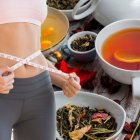 Gained Extra Weight in the Lockdown? Best Slimming Tea to Get in the Right Shape and Live a Healthier Life
Gained Extra Weight in the Lockdown? Best Slimming Tea to Get in the Right Shape and Live a Healthier Life
-
 ग्रीन टी के सेवन से आपको ये 10 आश्चर्यजनक स्वास्थ्य लाभ मिल सकते हैं। 1 दिन में कितना सेवन करें। ग्रीन टी के बारे में महत्वपूर्ण जानकारी।(2020)
ग्रीन टी के सेवन से आपको ये 10 आश्चर्यजनक स्वास्थ्य लाभ मिल सकते हैं। 1 दिन में कितना सेवन करें। ग्रीन टी के बारे में महत्वपूर्ण जानकारी।(2020)
-
 Start Living a Healthier Life with the Use of Green Tea. Discover the Multiple Benefits of Drinking Green Tea and the Right Way to Prepare a Cup of Green Tea (2020)
Start Living a Healthier Life with the Use of Green Tea. Discover the Multiple Benefits of Drinking Green Tea and the Right Way to Prepare a Cup of Green Tea (2020)
Know All about Herbal Teas!
How is Herbal Tea Better than Normal Tea?
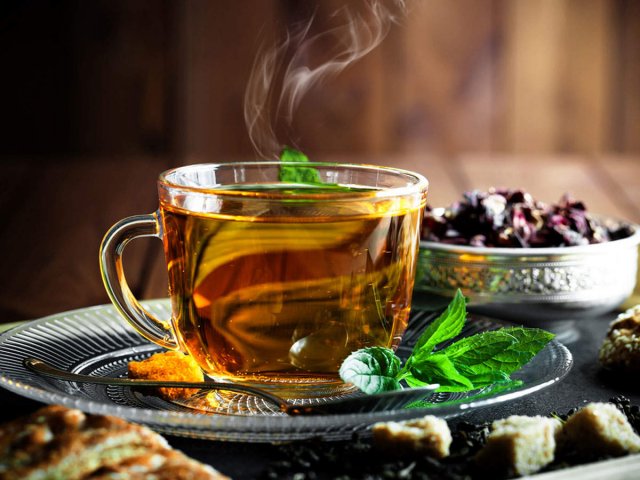
Normal Tea comes from Camellia sinensis or typically known as the tea plant, the leaves of which are harvested and then cured. Tea leaves contain caffeine as such and while a little bit of caffeine is good, too much of it can make you anxious, give way to rapid heartbeat and play havoc with your sleep. Herbal Tea, on the other hand is refreshing for your mind, body and spirit. It actually serves as blessing in disguise with a multitude of health benefits that include hydrating your body, aiding digestion, help sleep better, reduce your stress, control blood sugar, reduce and prevent inflammation, lower blood pressure and more!
What are the Side Effects of Drinking Herbal Tea?
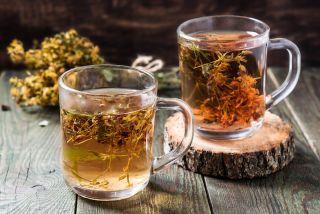
Even though herbal tea is mostly safe, there are some varieties that can have certain side effects, if consumed in large volume, as they may interact with certain medications, food allergies, etc. Some side effects, if any associated with herbal teas include headache, soreness in the mouth, skin flush, dermatitis, heartburn, nausea, dizziness or hormonal imbalance. Certain medicines like Aspirin, anticoagulants and blood thinner can lead to liver or kidney damage in combination with herbal teas. To avoid the risk of herbal teas, it is best to stick to infusions from companies that offer fine tea blends. Always appraise your doctor of your herbal tea consumption (if any) and be aware of any herbal dietary supplements or extracts.
How to Steep Herbal Teas?
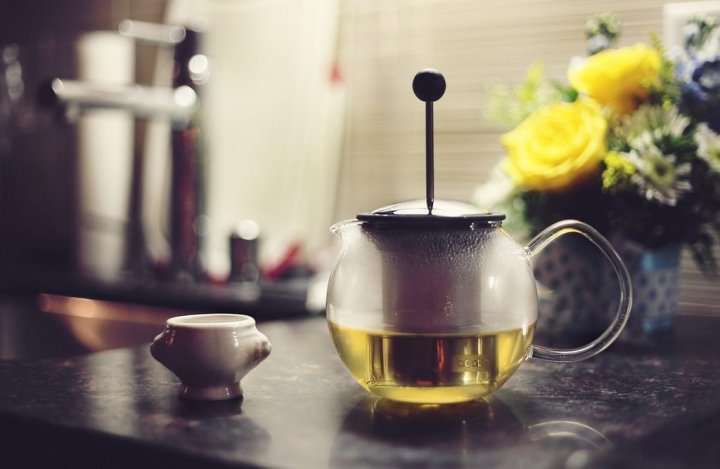
A warm cup of your favorite tea can chase away all blues, recharge your batteries and relax you at night. Herbal Teas, more specifically also known as Tisanes are essentially infusions made out of roots, leaves, stems and flowers of plants or herbs. Often made using dried ingredients, herbal teas can also be made from fresh ingredients. The basic steeping technique for normal and herbal teas is typically the same, however the volume needed to brew a cup can vary between fresh and dried ingredients. The temperature and time taken to extract the distinct and desired flavor can also differ.
If you’re making your herbal tea from fresh ingredients, it is best to use them as soon as they are purchased or cut, while dried tea leaves have a long shelf life and hence if kept in airtight containers and away from direct sunlight can be used well. However, longer storage can negatively impact their quality, aroma and flavor. To steep your herbal tea, pour hot water over the ingredients and let it all rest for few minutes. You can experiment with the brew time depending on the taste you prefer. While a longer steep doesn’t necessarily taste better, a shorter brew won’t really extract the required flavor or anti-oxidants.
Healthy and Flavourful: List of Best Herbal Teas You can Try Out
Lemon Balm
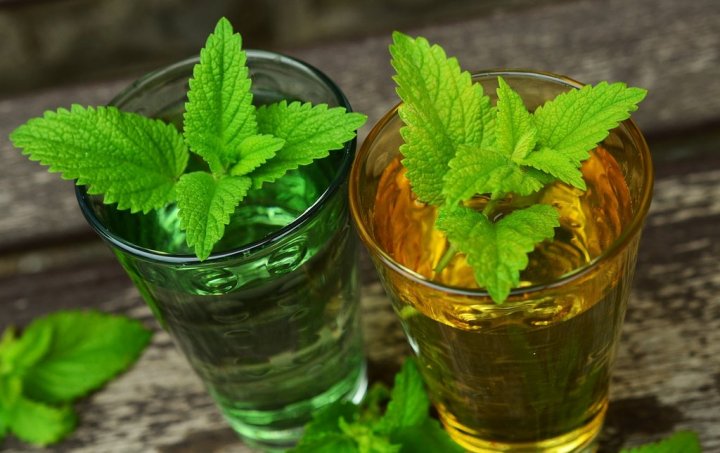
A healthy herb that’s been taken from the mint family, Lemon Balm’s leaves are used to make medicines and cure varied ailments like stomach upset, menstrual cramps, digestive trouble, melancholia, toothache, mental disorder, headache and more. Owing to its calming properties, Lemon Balm is recommended for those who suffer from anxiety, insomnia, high blood pressure, restlessness and treat diseases like Alzheimers, it can also be used to treat insect bites, herpes and other skin conditions. Lemon Balm is typically used to flavor tea, acting as a sedative to reduce harmful viruses, increase anti-oxidants in the body, improve the heart’s functioning and soothe the skin. Lemon balm should be avoided by people suffering from hypothyroidism as it can interact with the thyroid medicines.
Procedure
- For Lemon Balm Tea, you need ¼ cup of chopped lemon balm leaves, a cup of water and a tsp of raw honey.
- Steep the leaves in boiled water for about 10 minutes, stir in honey, strain and then drink warm.
Chamomile
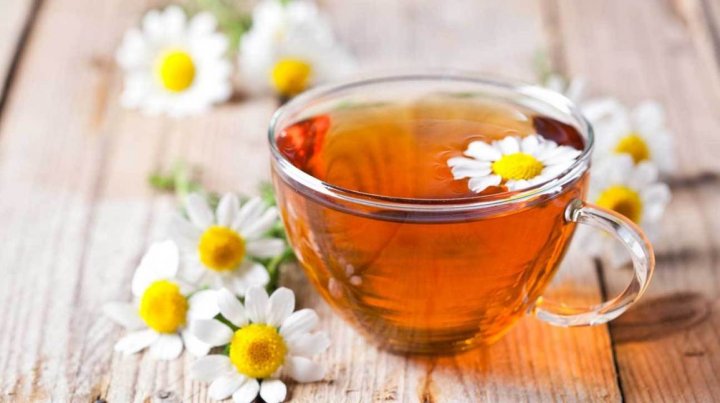
An ever popular herbal remedy across the globe, Chamomile has been in use for centuries, renowned for its calming properties. With the ability to reduce inflammation, treat stomach disorders, aid sleep and promote muscle relaxation, Chamomile has varied medicinal benefits and can keep you healthy. Extracted from the daisy flower, Chamomile’s naturally healing composition is the perfect remedy for several ill-health conditions. Chamomile Herbal Tea is prepare by using its dried flowers and brewed in water. Caffeine free, it is the best substitute for black and green teas. Its antioxidant properties play a significant role in lowering the risks of heart diseases and cancer, protect the liver, fight stomach ulcers, and improve the blood sugar, insulin and blood lipid levels.
Procedure
- To make Chamomile Tea, take 3-4 tbsps of Chamomile, a mint sprig and pour 1 cup of boiling water over the dried flowers and mint.
- Let it steep for 5 minutes, strain and drink warm.
Peppermint
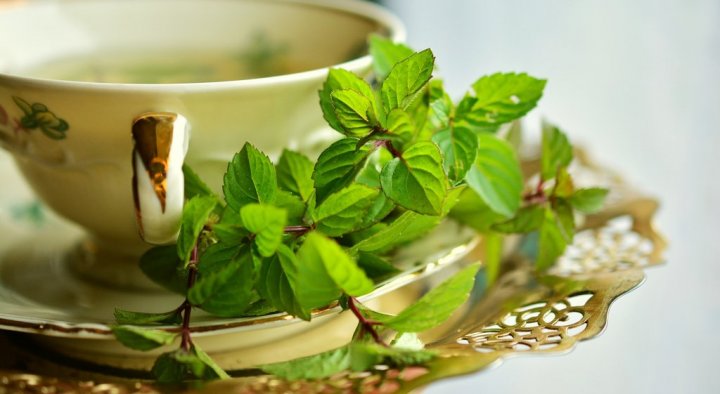
Used all over the world, Peppermint’s known for its refreshing and relaxing properties. With a slightly sweet and energizing flavor that can help with foul breath, Peppermint’s most essential benefits include relief from stress, improved immune system, relief from common cold symptoms, reprieve from digestion trouble and stomach disorders. Peppermint tea’s a blend of peppermint plant leaves which are free of caffeine and include vitamins like A, C, potassium, magnesium and calcium. Peppermint Tea can help reduce headaches and menstrual cramps, treat sinus and fight bacterial infections inside owing to its anti-bacterial, anti-viral, anti-cancer and anti-oxidant properties.
Procedure
- For peppermint tea, take 2 cups of boiling water, add 15 fresh mint leaves and steep for 10-15 minutes.
- You can either strain the leaves or chew on them and serve the tea warm with a drop or two of honey and a squeeze of lemon.
Hibiscus
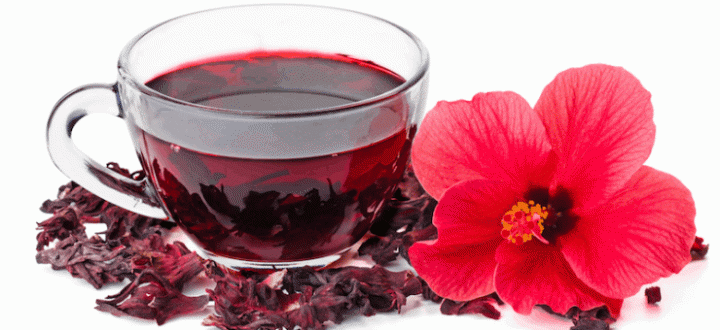
With its numerous health benefits, Hibiscus Tea is made from the colorful flowers of the hibiscus plant and has a refreshing and sharp flavor. Enjoyed both as hot or iced tea, Hibiscus’s essential benefits include the treatment of high blood pressure, high cholesterol, liver conditions, indigestion, cancer, aid in weight loss, reduce anxiety and stress. Enriched in vitamin C, minerals and anti-oxidants, Hibiscus Tea has anti-viral properties as well. Those on diuretic medication should avoid hibiscus tea, as the two may interact with each other, and can also affect the healing properties of aspirin, hence its best to intake the tea after 3-5 hours of taking medication. Hibiscus tea is best taken iced.
Procedure
- Just add the flowers to a mason jar, pour cold water over the dried flowers and screw on the lid.
- Refrigerate it overnight, sieve the flowers, sweeten the tea to your liking and have it iced.
Ginger
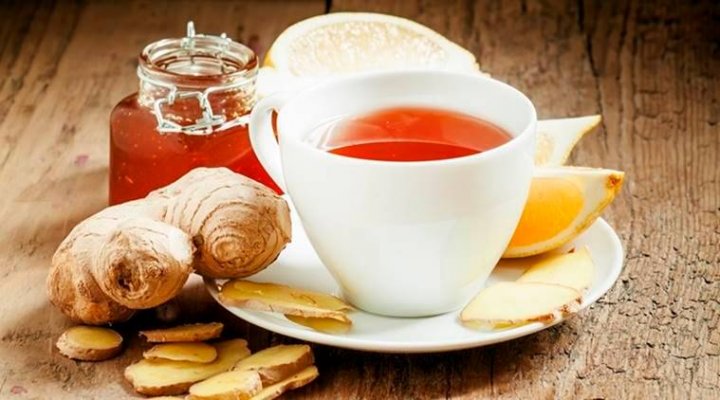
A spicy flavored drink which includes disease-fighting anti-oxidants, Ginger Tea not only strengthens the immune system but also fight inflammation. It is one of the best remedies to treat nausea, fight stomach ulcers and treat constipation and indigestion. Ginger tea can also protect the brain and the heart, lower blood sugar and comes with anti-cancer properties. It can also relieve menstrual pain and dysmenorrhea. Ginger tea can also be beneficial for people with Diabetes.
Procedure
- To make ginger tea, fill a medium pot with 2 cups of water, and place some ginger slices.
- Let the liquid boil for 10-20 minutes, depending on how strong you’d like your tea to be.
- Remove from heat, add a lime and honey to taste and have it warm.
Passionflower

Made of the stem and flower of the Passion Flower Plant, the herbal tea acts like a medicine to cure anxiety disorders, improve sleep patterns, treat ADHD and heart conditions. Used mostly as a flavoring agent in food, passionflower has properties with calming effect. Passionflower is essentially a creeper plant that’s mostly found in southeastern, southern and central parts of America.
Procedure
- To make passionflower tea, you need to brew dried passion flower in hot water for about 6-8 minutes, or 10-15 minutes if you’d like the tea stronger.
- Strain and then sweeten it with honey to taste and drink warm.
Rooibos
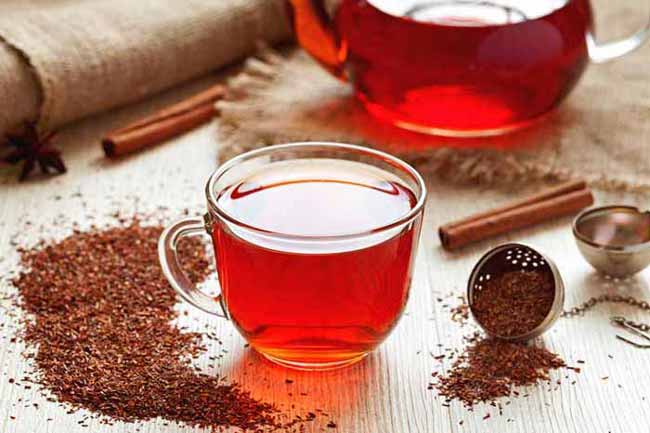
A South African Herbal Tea, Rooibos is made of the leaves of the Rooibos (red bush plant) and has been in use from ancient times owing to its medicinal properties, albeit without much scientific results. With its anti-oxidant and caffeine free properties, it can be consumed either hot or iced and is immensely beneficial for the skin, especially in terms of keeping it refreshed and wrinkle-free! Rooibos also prevents inflammation, helps with heart conditions, diabetes, treat asthma, hypertension, reduce cholesterol, treat colic in babies and increase the air flow to the lungs. Rooibos has a distinct earthy and sweet flavor that blends with other herbs, fruits and flowers really well.
Procedure
- To make Rooibos tea, use a cup of water.
- Boil it and add a tsp of loose Rooibos leaves.
- Allow it to steep for about 5 minutes or so and then add honey to taste and drink warm.
Sage
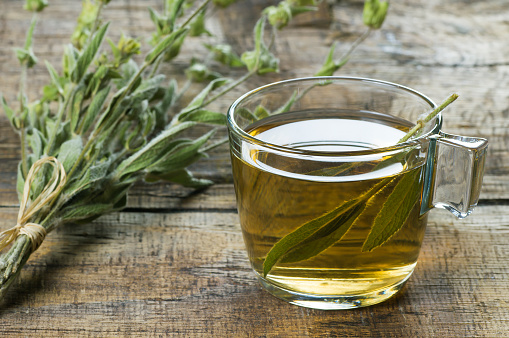
Traditionally known for pain relief, treating brain disorders, combat anxiety, prevent cancer, detoxify the body and aid in weight loss, Sage is also beneficial for fighting again depression, diabetes, lupus, dementia and more. made from the leaves of the Sage plant and used as one of the most popular herbs in most cuisines.
Procedure
- Sage Tea can be made by adding 2 tbsps of fresh common sage leaves or a tbsp. of dried sage leaves to a cup of boiled water.
- Steep the blend for 5-6 minutes, strain the leaves and then drink warm.
Holy Basil
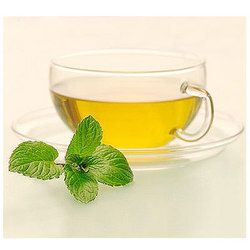
An adaptogenic, Tulsi or Holy Basic has been in use for centuries to reduce stress naturally and for overall well-being. A great source of healing for dealing with lifestyle-related diseases, Holy Basil has antioxidant, anti-inflammatory, anti-diabetic, anti-cancer, radioprotective and anti-microbial properties. It can also help heal arthritis and fibromyalgia. However, Tulsi should be avoided by women trying to conceive.
Procedure
- To take Holy Basil Tea, lay out tulsi sprigs in a single line and let it wilt.
- Boil some water and put the dried sprigs into it.
- Allow the liquid to steep for 15 minutes and then strain and drink warm or iced.
Olive Leaf
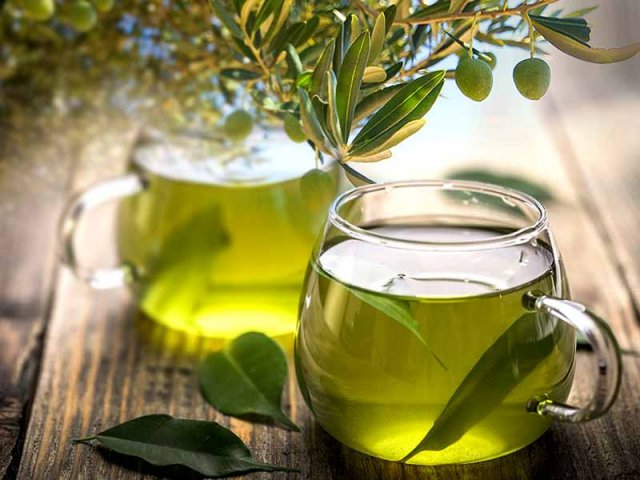
An unexplored gem, in the realm of herbal remedies, Olive Leaf is mostly used so in Mediterranean countries for treating varied health problems. Made of dried olive tree leaves, Olive Leaf Herbal Tea is refreshing and has potential healing properties to fight against cancer, lowering cholesterol and blood sugar, aid in weight loss, reducing cardiovascular risks like atherosclerosis, eliminate free radicals, fight herpes, reduce inflammation and more.
Procedure
- Since olive leaves are bitter to taste, it is best to make it with a blend of peppermint or ginger with 1 tbsp of dried olive leaves in a cup of boiling water.
- Steep the liquid covered for about 15 minutes and then drink warm.
Bonus Tips: Additives to Make Your Tea Taste Better!
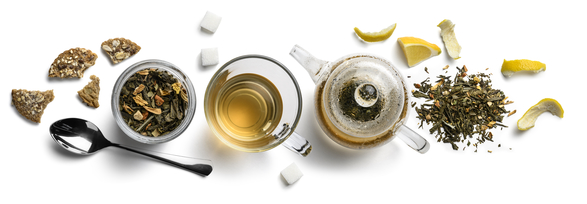
Tea without additives can sometimes taste quite bland. At times, you need an extra zing, kick or jest to make your concoction more tasty and exciting. Here are some additive that will make your ‘not so exciting’ tea seem a delicious treat!
- Citrus – fruits like grapefruit, lime, lemon or orange can work as natural sweeteners, whether cut in slices or squeezed as juice into the cup. Use with or without a strainer. This works best for citrus tea flavors.
- Beries – may seem like odd add to a tea, but a blend of strawberries, raspberries and blueberries will fill you up, in addition to adding some sweetness and texture to the tea, especially during the spring and summer months. Best had with peace, hibiscus, blueberry or lavender teas.
- Cinnamon – works really well during fall afternoons or wintery nights adding a bit of spice to your tea. The flakiness of this spicy herbs will dissolve when stirred and mask the herbal tea’s taste, best had with cinnamon, vanilla, chocolate or pumpkin teas.
- Honey – is a classic ingredient which adds a silky and soft texture and flavor to the tea and works really well with orange, chamomile, lemongrass or lemon teas.
- Lemon Thyme/Basil or Verbana – with these 3 herbs can make your tea more aromatic and flavorful. Works best with ginger, citrus, chamomile, green or true teas.
- Maple Syrup – is great for green, vanilla, chocolate, cinnamon or caramel teas and cures any disgusting tea with just a drop or two of its gooey, golden goodness!
-
 Gained Extra Weight in the Lockdown? Best Slimming Tea to Get in the Right Shape and Live a Healthier Life
Gained Extra Weight in the Lockdown? Best Slimming Tea to Get in the Right Shape and Live a Healthier Life
-
 13 Diwali Gift Ideas for Corporates Who Want to Make the Right Impression in 2019 (Updated)
13 Diwali Gift Ideas for Corporates Who Want to Make the Right Impression in 2019 (Updated)
-
 Step into the Sweet, Sour and Even Umami Worlds of Kombucha Tea and the Japanese Kombu Cha! Find the Difference or Dive into Their Healing Depths. Recipes Included!
Step into the Sweet, Sour and Even Umami Worlds of Kombucha Tea and the Japanese Kombu Cha! Find the Difference or Dive into Their Healing Depths. Recipes Included!
-
 10 Elegant Business Gifts to Laud Your Associates, Business Partners and Clients, and to Foster Stronger Alliances in 2019
10 Elegant Business Gifts to Laud Your Associates, Business Partners and Clients, and to Foster Stronger Alliances in 2019
-
 Introduce Your Friends and Family to a Great New Way to Health and Wellness: 30 Top Herbal Tea Gift Sets to Show How Much You Care for Your Loved Ones (2022).
Introduce Your Friends and Family to a Great New Way to Health and Wellness: 30 Top Herbal Tea Gift Sets to Show How Much You Care for Your Loved Ones (2022).
Check out the Best Herbal Tea List for 2020 and Stay Healthy
Although most of the recipes are without side effects, it is always better to check for any, as different persons have different reactions. For instance as mentioned above, hibiscus tea to be avoided by those on diuretic medication. So be aware and stay healthy.

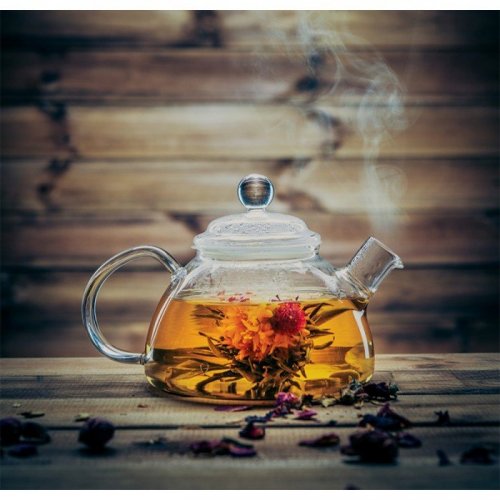
 Highlight the Best Facets of Your Incomparable Beauty: Discover the Best Face Highlighter Currently Available in India and Everything You Need to Know About Using Face Highlighters for Maximum Effect (2023)
Highlight the Best Facets of Your Incomparable Beauty: Discover the Best Face Highlighter Currently Available in India and Everything You Need to Know About Using Face Highlighters for Maximum Effect (2023)
 Forget the Blemishes and Get that Picture Perfect Flawless Radiance on Your Face: Check out the Best Foundations for Oily Skin Currently Available in India and Everything You Need to Know About Makeup Foundations (2023)
Forget the Blemishes and Get that Picture Perfect Flawless Radiance on Your Face: Check out the Best Foundations for Oily Skin Currently Available in India and Everything You Need to Know About Makeup Foundations (2023)
 Make Your Presence Felt Wherever You Go: Discover the Best Perfumes Under 2000 for Both Men and Women to Announce Your Arrival and Make Any Occasion Memorable (2023)
Make Your Presence Felt Wherever You Go: Discover the Best Perfumes Under 2000 for Both Men and Women to Announce Your Arrival and Make Any Occasion Memorable (2023)
 Protect Your Oily Skin from the Harmful Rays of the Sun: Discover the Best Gel Based Sunscreens for Oily Skin and Everything You Need to Know Before Buying One (2023)
Protect Your Oily Skin from the Harmful Rays of the Sun: Discover the Best Gel Based Sunscreens for Oily Skin and Everything You Need to Know Before Buying One (2023)
 Minor Blemishes and Wrinkles Affecting Your Confidence? Check out the Best BB Creams to Conceal Your Worries and Nourish Your Skin to Restore the Healthy, Radiant and Glowing Complexion Back Again (2023)
Minor Blemishes and Wrinkles Affecting Your Confidence? Check out the Best BB Creams to Conceal Your Worries and Nourish Your Skin to Restore the Healthy, Radiant and Glowing Complexion Back Again (2023)
